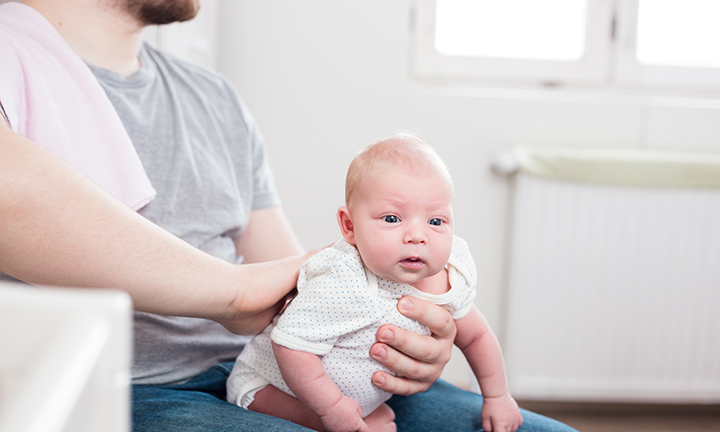
What Is Paced Bottle-Feeding?
3 min readUpdated September 09, 2025
3 min readUpdated September 09, 2025
Paced bottle-feeding is an approach that mimics natural breastfeeding rhythms, giving infants control over the flow and timing of their feeds. It's particularly helpful for babies who alternate between bottle and breast, reducing the risk of overfeeding, colic, and gas. This method may help promote healthy self-regulation, nurture the parent-baby bond, and support successful breastfeeding transitions. Clinical guidance supports responsive feeding over rigid schedules.
Benefits may include:
Key steps include:
In the following sections, we'll guide you through step-by-step instructions, troubleshooting tips, and how to make this method part of your daily routine.
What Is the Paced Bottle-Feeding Method?
Paced bottle feeding is a responsive method that slows down milk flow, allowing babies to manage when and how much they drink. Unlike traditional bottle feeding, which uses continuous flow, paced feeding with a bottle replicates breastfeeding’s rhythm of suck–swallow–pause. It’s ideal for breastfed babies introduced to bottles, as well as exclusively bottle-fed infants
Check with your baby's healthcare provider if you have any questions about paced bottle-feeding or about feeding in general.
Why Paced Bottle-Feeding Can Be Beneficial for Babies
The benefits of paced bottle-feeding may include the following:
When to Introduce a Bottle to a Breastfeeding Newborn
If you are breastfeeding and wish to start bottle-feeding your baby, either paced or not, wait until breastfeeding is well-established—typically around 3 to 4 weeks—but only if necessary (e.g., returning to work). For babies exclusively formula-fed, you can begin paced feeding immediately to mimic responsive habits.
Step-by-Step Paced Bottle-Feeding Technique
Wondering how to pace bottle feed? Here are four steps for introducing paced bottle-feeding to your baby:
Spotting Hunger and Fullness Cues
Recognizing your baby’s cues is essential to responsive feeding, whether breastfed or bottle-fed. Sometimes, parents wonder, “Why is my newborn still hungry after feeding?” or worry when a baby is pushing the bottle away but still seems hungry. These situations can be confusing, but paying close attention to subtle cues helps clarify whether your newborn is truly still hungry or simply needs a break.
Hunger Signs:
If your newborn seems still hungry after feeding, it may be because they didn’t finish a full feed or were interrupted before they were ready. In paced bottle-feeding, offering pauses can sometimes cause frustration—watch closely for whether they are actively rooting or just need a moment.
Fullness Cues:
If your baby is pushing the bottle away but still seems hungry, try offering a brief pause, a burp, or repositioning. Babies sometimes need a moment to decide whether they want more, especially if gas or overstimulation is at play.
Understanding these patterns will help you respond more confidently and avoid unnecessary overfeeding.
Tips and Things to Consider for Paced Bottle-Feeding
Mastering the paced bottle-feeding technique goes beyond just bottle angle and nipple flow; it also requires a responsive, baby-led mindset and consistent support from everyone involved in your baby's care. These tips help ensure the experience supports healthy development, reduces risks of overfeeding, and encourages smooth transitions between bottle and breast.
Paced Bottle-Feeding at Night
Night feeds can follow the same responsive-paced approach: hold upright, use slow flow, pause frequently, and follow your baby’s cues. As your baby grows (from 6 to 9 months), they may start to self-hold or transition to sippy cups. It is recommended to transition off bottles by 12 to 18 months to prevent tooth decay, in accordance with CDC and AAP guidelines.
When to Consult Your Healthcare Provider
Contact your baby’s healthcare provider if you notice:
Your healthcare provider or lactation consultant can help tailor feeding strategies to your baby's needs.
FAQS AT A GLANCE
Paced bottle-feeding is a baby-led feeding technique that mimics the rhythm of breastfeeding. It involves holding the bottle horizontally, using a slow-flow nipple, and allowing the baby to suck and pause naturally. This method may help reduce overfeeding, gas, and support a smooth transition between breast and bottle.
The Bottom Line
Whether you’re bottle-feeding with formula or expressed breast milk, paced bottle-feeding supports a gentler, more natural rhythm. It may help your baby regulate intake, reduce digestive issues, and it also aligns with trusted medical guidance for responsive feeding.
With feeding comes plenty of diaper changes. So, why not earn rewards on all those diapers and wipes by downloading the Pampers Rewards app today? You deserve it!
- American Academy of Pediatrics. Caring for Your Baby and Young Child: Birth to Age 5, 7th ed. (New York: Bantam Books, 2019).
- AAP. Infant Food and Feeding
- CDC: Signs Your Child is Hungry or Full
- Cleveland Clinic: Colic
- Healthy Children. Bottle Feeding Basics
- Healthy Children: Colic Relief Tips for Parents
- Healthy Children. Is Your Baby Hungry or Full? Responsive Feeding Explained
- LLLI: Bottles: FEEDING BREASTMILK other than at the breast
- LLLI: Introducing a Bottle to a Breastfed Baby
- LLLI: Skin-to-Skin Contact
- MN Department of Health: Paced Bottle Feeding: Infant Feeding Series
- National Library of Medicine. Responsive Feeding Recommendations: Harmonizing Integration into Dietary Guidelines for Infants and Young Children
Read more about Baby
Related Articles
Join a World of Support
through Pregnancy and Parenthood.
TRACK WITH TOOLS
LEARN WITH EXPERTS
GET REWARDED








